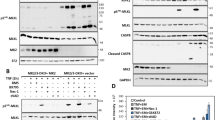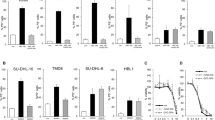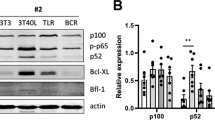Abstract
NF-κB transcription factors promote survival in numerous cell types via induction of antiapoptotic genes. Pharmacological blockade of the IKK2 kinase with AS602868, a specific inhibitor that competes with ATP binding, prevented TNF-α-induced NF-κB activation in Jurkat leukemic T cells. While TNF-α by itself had no effect on Jurkat survival, the addition of AS602868 induced cell death, visualized by DNA fragmentation and sub-G1 analysis. A disruption of the mitochondrial potential followed by activation of caspases 9 and 3 was observed in cells treated by the combination TNF-α+AS602868. Quantitative real-time PCR demonstrated that AS602868 prevented TNF-α induction of the antiapoptotic genes coding for c-IAP-2, Bclx, Bfl-1/A1 and Traf-1. The use of a specific IKK2 inhibitor appears, therefore, as an interesting pharmaceutical strategy to increase the cell's sensitivity towards apoptotic effectors.
This is a preview of subscription content, access via your institution
Access options
Subscribe to this journal
Receive 50 print issues and online access
$259.00 per year
only $5.18 per issue
Buy this article
- Purchase on Springer Link
- Instant access to full article PDF
Prices may be subject to local taxes which are calculated during checkout





Similar content being viewed by others
References
Adams J . (2002). Trends Mol. Med., 8, S49–S54.
Ashkenazi A and Dixit V . (1998). Science, 28, 1305–1308.
Baldwin Jr A . (2001). J. Clin. Invest., 107, 3–6.
Bradley J and Pober J . (2001). Oncogene, 20, 6482–6491.
Burke JR, Miller KR, Wood MK and Meyers CA . (1998). J. Biol. Chem., 273, 12041–12046.
Busuttil V, Bottero V, Frelin C, Imbert V, Ricci J, Auberger P and Peyron J-F . (2002). Oncogene, 21, 3213–3224.
Chen G and Goeddel D . (2002). Science, 296, 1634–1635.
Cheng Q, Lee H, Li Y, Parks T and Cheng G . (2000). Oncogene, 19, 4936–4940.
Chomczynski P and Sacchi N . (1987). Anal. Biochem., 162, 156–159.
Chu Z-L, McKinsey T, Liu L, Gentry J, Malim M and Ballard D . (1997). Proc. Natl. Acad. Sci. USA, 94, 10057–10062.
Dajee M, Lazarov M, Zhang J, Cai T, Green C, Russell A, Marinkovich M, Tao S, Lin Q, Kubo Y and Khavari P . (2003). Nature, 421, 639–643.
Foo S and Nolan G . (1999). Trends Genet., 15, 229–235.
Garg A and Aggarwal B . (2002). Leukemia, 16, 1053–1068.
Gross A, McDonnell J and Korsmeyer S . (1999). Genes Dev., 13, 1899–1911.
Hanahan D and Weinberg RA . (2000). Cell, 100, 57–70.
Hideshima T, Richardson P, Chaudan D, Palombella V, Elliott P, Adams J and Anderson K . (2001). Cancer Res., 61, 3071–3076.
Jones B, Lo C, Srinivasan A, Streetz K, Valentino K and Czaja M . (2000). J. Biol. Chem., 275, 705–712.
Karin M . (1999). Oncogene, 18, 6867–6874.
Karin M, Cao Y, Greten F and Li Z . (2002). Nat. Rev. Cancer, 2, 301–310.
Karin M and Lin A . (2002). Nat. Immunol., 3, 221–227.
Keane M, Rubinstein Y, Cuello M, Ettenberg S, Banerjee P, Nau M and Lipkowitz S . (2000). Breast Cancer Res. Treat., 64, 211–219.
Pagliari L, Perlman H, Liu H and Pope R . (2000). Mol. Cell. Biol., 20, 8855–8865.
Pahl H . (1999). Oncogene, 18, 6853–6866.
Rayet B and Gélinas C . (1999). Oncogene, 18, 6938–6947.
Salvesen G and Duckett C . (2002). Nat. Rev., 3, 401–410.
Sugiyama H, Savill J, Kitamura M, Zhao L and Stylianou E . (1999). J. Biol. Chem., 274, 19532–19537.
Van Antwerp DJ, Martin SJ, Kafri T, Green DR and Verma IM . (1996). Science, 274, 787–789.
Van Antwerp DJ, Martin SJ, Verma IM and Green DR . (1998). Trends Cell Biol., 8, 107–111.
Vindelov L, Christensen I and Nissen N . (1983). Cytometry, 3, 323–327.
Wang C, Guttridge D, Mayo M and Baldwin JR A . (1999a). Mol. Cell. Biol., 19, 5923–5929.
Wang C, Mayo M, Korneluk R, Goeddel D and Baldwin Jr A . (1998). Science, 281, 1680–1683.
Wang C-Y, Cusack Jr J, Liu R and Baldwin Jr A . (1999b). Nat. Med., 5, 412–417.
Wang CY, Mayo MW and Baldwin Jr AS . (1996). Science, 274, 784–787.
Yamamoto Y and Gaynor R . (2001). J. Clin. Invest., 107, 135–142.
Yin M, Yamamoto Y and Gaynor R . (1998). Nature, 396, 77–80.
Acknowledgements
We would like to thank Drs Ched Grimshaw and Shripad Bhagwat (Celgene Corporation, USA) for sharing information about properties of AS602868. This work was supported by institutional grants from INSERM, by a grant from La Fondation de France, comité Leucémies and by a research grant from Serono International SA (Geneva, Switzerland).
Author information
Authors and Affiliations
Corresponding author
Rights and permissions
About this article
Cite this article
Frelin, C., Imbert, V., Griessinger, E. et al. AS602868, a pharmacological inhibitor of IKK2, reveals the apoptotic potential of TNF-α in Jurkat leukemic cells. Oncogene 22, 8187–8194 (2003). https://doi.org/10.1038/sj.onc.1206963
Received:
Revised:
Accepted:
Published:
Issue Date:
DOI: https://doi.org/10.1038/sj.onc.1206963
Keywords
This article is cited by
-
Sensitivity and gene expression profile of fresh human acute myeloid leukemia cells exposed ex vivo to AS602868
Cancer Chemotherapy and Pharmacology (2011)
-
Complement-mediated regulation of the IL-17A axis is a central genetic determinant of the severity of experimental allergic asthma
Nature Immunology (2010)
-
Chemical biology of inflammatory cytokine signaling
The Journal of Antibiotics (2009)
-
Kinase inhibitors for the treatment of inflammatory and autoimmune disorders
Purinergic Signalling (2009)
-
Pharmacological targeting of NF-κB potentiates the effect of the topoisomerase inhibitor CPT-11 on colon cancer cells
British Journal of Cancer (2008)



